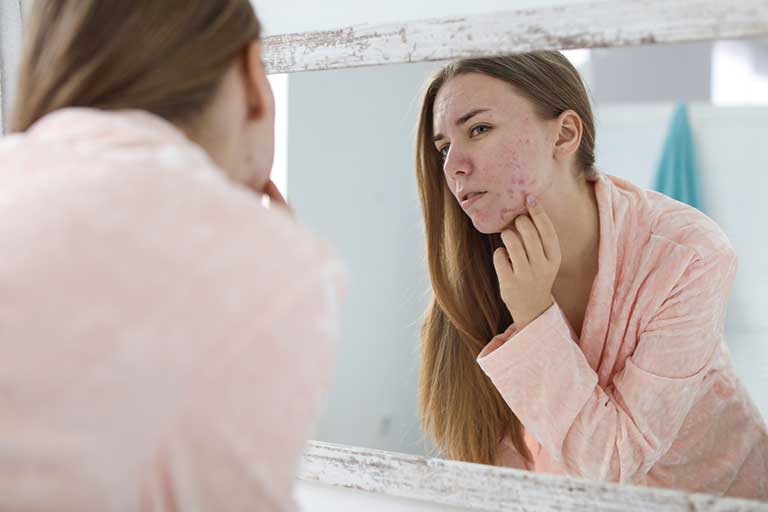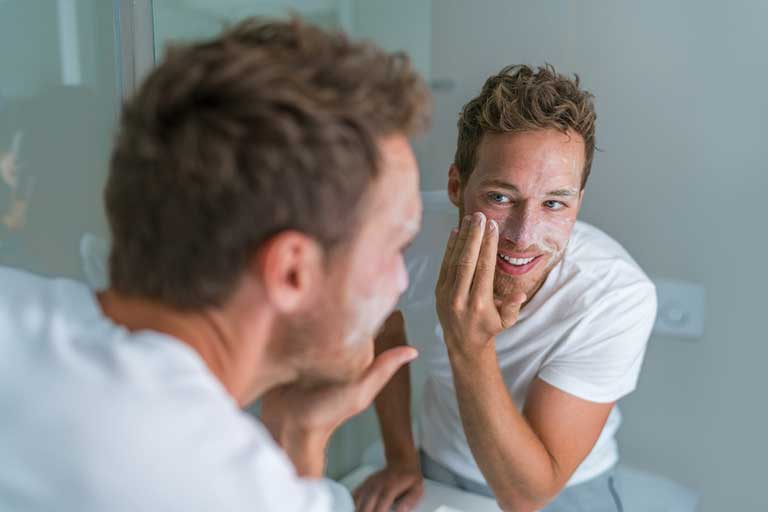Acne
Acne is a skin disorder that usually appears in adolescence and causes blackheads and pimples. Acne can leave scars and have psychological repercussions. Therefore, it is important to treat it early.

What is Acne?
Acne vulgaris, also known simply as acne, is one of the most common skin disorders affecting the so-called pilosebaceous units, which are formed by hair follicles (holes where hair grows out of the skin) and sebaceous glands (glands that secrete fat to keep hair and skin lubricated). It is characterized by the chronic development of papules, pustules and nodules. It may occur with inflammatory and non-inflammatory lesions, mainly on the face, but also on the upper arms, trunk and back. The clinical manifestation of this disorder varies, ranging from non-inflamed open and closed comedones ("blackheads" and "whiteheads") to more severe forms, such as papules, pustules and inflammatory nodules.

Acne is more common among adolescents and young adults, specially males, but it is not limited to these ages. It is estimated that about 35%-90% of adolescents develop acne. It usually appears at 7-12 years old and disappears by the age of 30. However, there may be cases in which it lasts more years or reappears at an adult age, being these cases more common in women.
Although acne is not a disease that causes a physical inability, its psychological impact may be significant, leading people who suffer it to develop low self-esteem, depression and anxiety.

What causes Acne?
The origin and development of acne involves different factors, the interaction of which leads to the formation of lesions called comedones and inflammation. During adolescence, acne is triggered by the sensitivity of sebaceous glands to hormones, particularly androgens, and to an excessive increase of Cutibacterium acnes, a bacterium usually found in follicles. That may be influenced by other factors such as genetics and, possibly, diet.
Symptoms and Signs
Acne vulgaris occurs in those areas of the body with large sebaceous glands that respond to hormones, like the face, neck, chest, upper back and upper arms, with different types of active lesions being present in the same area.
The severity and reach of acne may vary, from the periodical occurrence of a few small comedones to the chronic presence of numerous inflamed nodules that affect most of the skin in the affected area.
After the acne disappears, the most common sequelae are hyperpigmentation and scars.
Diagnosis
Acne vulgaris is usually diagnosed through a physical examination. There is no test for acne. Rarely, a doctor may take a swab or scraping of a lesion or pustule for microbiological examination or culture to rule out other sources of infection.
For women, hormone blood tests may be ordered to look for i.e high testosterone (an indicator of polycystic ovaries).

Treatment
There is not one single effective treatment for acne, so sometimes a combination of treatments is recommended. Since acne lesions take at least eight weeks to mature, the treatment must be maintained for a minimum of two to three months before deciding if it is effective.
Topical Products
Topical drugs are of major importance and widely prescribed in acne therapy. The most effective topical treatments in acne are retinoids, benzoyl peroxide, antibiotics and azelaic acid. They are indicated in mild to moderate acne, and also in moderate to severe acne in association with systemic (oral) treatments.
Oral Therapy
Oral antibiotics: Oral antibiotics act by reducing C. acnes and directly decreasing inflammation. They are used for moderate and severe acne, and also acne extending over the chest and/ or back. Tetracyclines (like doxycycline, lymecycline minocycline and sarecycline) are the first choice before macrolides (like erythromycin and azithromycin) due to fewer side effects, including in particular antibiotic resistance.
Oral hormones: The most effective hormonal treatments for acne are combined oral contraceptives. Among the available combined oral contraceptives, the ones containing progestins with an antiandrogenic effect (like cyproterone acetate, drospirenone and chlormadinone acetate) are preferred among patients with acne.
Oral retinoids: Oral isotretinoin is a naturally occurring molecule, and part of the metabolic chain that ends up in vitamin A products. It is indicated in severe acne or acne that doesn’t respond adequately to an appropriate course of therapy with systemic antibiotics and topical treatments.
Other Acne Therapies
A recently published study shows that red light, blue light, yellow light, infrared light, and pulsed dye laser can’t be considered as a first-line therapy in acne. These procedures can be used in association with standard therapies in selected cases.
Cosmetic products provide an unavoidable support to standard treatments. Their correct use may counteract the irritation induced by some standard therapies and help maintain the skin in a physiologically balanced situation.

Care of Skin with Acne:
Skin care is essential for the treatment of acne. For the treatment to be more effective, some habits must be followed.
- Skin Hygiene: The face should not be washed more than twice a day with warm water (not hot) and a mild facial cleanser without soap. It is not recommended to use vegetable towelettes or sponges or rub the face because it may worsen acne and damage skin. Pimples should not be squeezed because it may worsen acne and cause swelling and leave scars on the skin, or it may help lesions to get infected.
- Moisturizing Creams: The use of a moisturizing cream reduces skin dryness and, therefore, desquamation. You must use creams with labels indicating that they are non-comedogenic to reduce the probability of skin pores plugging.
- Sun Protection: Some acne treatments, such as retinoids or doxycycline, increase skin sensitivity to sunlight, so it is advisable to avoid excessive sun exposure and always use sun protection factor (SPF) of 30 or higher, which blocks both ultraviolet A (UVA) and ultraviolet B (UVB) radiation.
References
- Sutaria Amita H, Masood Sadia SJ. Acne vulgaris. StatPearls - NCBI Bookshelf. CRC Press; 2019. Available at: https://europepmc.org/article/med/29083670
- Thiboutot D, Zaenglein A. Pathogenesis, clinical manifestations, and diagnosis of acne vulgaris. UpToDate. 2015;1–51. Available at: https://www.uptodate.com/contents/pathogenesis-clinical-manifestations-and-diagnosisof-acne-vulgaris
- Yazici K, Baz K, Yazici AE, Köktürk A, Tot S, Demirseren D, et al. Disease-specific quality of life is associated with anxiety and depression in patients with acne. J Eur Acad Dermatology Venereol. 2004 Jul;18(4):435–9. Available at: https://www.ncbi.nlm.nih.gov/pubmed/15196157
- Klassen AF, Newton JN, Mallon E. Measuring quality of life in people referred for specialist care of acne: Comparing generic and disease-specific measures. J Am Acad Dermatol. 2000 Aug;43(2 I):229–33. Available at: https://www.ncbi.nlm.nih.gov/pubmed/10906643
- Dalgard F, Gieler U, Holm JØ, Bjertness E, Hauser S. Self-esteem and body satisfaction among late adolescents with acne: Results from a population survey. J Am Acad Dermatol. 2008 Nov;59(5):746–51. Available at: https://www.ncbi.nlm.nih.gov/pubmed/19119094
- Webster GF, Leyden JJ, Nilsson UR. Complement activation in acne vulgaris: Consumption of complement by comedones. Infect Immun. 1979;26(1):183–6. Available at: https://www.ncbi.nlm.nih.gov/pmc/articles/PMC414592/
- Stathakis V, Kilkenny M, Marks R. Descriptive epidemiology of acne vulgaris in the community. Vol. 38, Australasian Journal of Dermatology. Blackwell Publishing; 1997. p. 115–23. Available at: https://onlinelibrary.wiley.com/doi/abs/10.1111/j.1440-0960.1997.tb01126.x
- Collier CN, Harper JC, Cafardi JA, Cantrell WC, Wang W, Foster KW, et al. The prevalence of acne in adults 20 years and older. J Am Acad Dermatol. 2008 Jan;58(1):56–9. Available at: https://www.ncbi.nlm.nih.gov/pubmed/17945383

